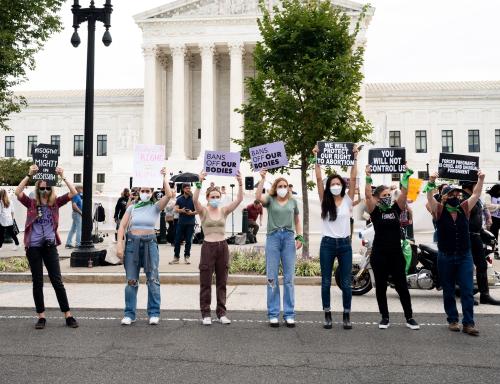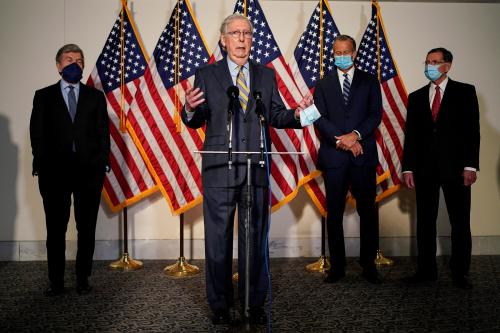In the vaccine mandate cases, Missouri v. Biden and National Federation of Independent Business v. OSHA, the Supreme Court rendered a split decision. Missouri v. Biden allowed the Biden administration to begin enforcing a rule that requires entities receiving Medicare or Medicaid funding to insist that their employees be vaccinated. National Federation of Independent Business v. OSHA prevents the Biden administration from enforcing a rule that would require businesses employing a hundred or more workers to insist that their employees who work in settings conducive to the spread of Covid either be vaccinated or wear masks and undergo regular coronavirus testing. The procedural posture of these cases is such that the Court technically didn’t render a decision on the validity of either rule. Rather the decisions determined whether the rules in question could go into effect while their legality is further litigated. The opinions of the Court are, however, such that the legality questions seem to have been answered. Mandates for health care workers are okay, while mandates for the ordinary employees of large businesses are not.
The decisions are already giving rise to considerable commentary. The ruling in National Federation is particularly open to criticism, much of it laid out in a dissent by the Court’s three liberal Justices, Breyer, Sotomayor and Kagan. The dissent argues, persuasively in my view, that in deciding that the OSHA rule was unauthorized, the majority gave a crabbed reading of the powers Congress gave OSHA. OSHA’s enabling act says that the agency should issue an emergency temporary standard if it determines (A) “that employees are exposed to grave danger from exposure to substances or agents determined to be toxic or physically harmful or from new hazards,” and (B) that the “emergency standard is necessary to protect employees from such danger.” Somehow the majority found that the fact that OSHA had never before had to enact rules to protect workers from conditions that facilitated the transmission of a deadly virus limited the reach of OSHA’s emergency standard rule. In so deciding, the majority appears to have turned the rule’s language on its head. Reading its opinion, one would think the law said that without specific Congressional authorization OSHA could not enact rules to protect against hazards so new that they had never previously been encountered.
The majority’s rationales for its position seem rooted in the rule’s likely impacts on people and the economy. Their magnitude is such that the majority feels change should not happen without specific Congressional approval. Implicit in this judgment is the hostility that many of the Court’s conservative Justices have toward the post 1930s administrative state and their desire to rein it in, if they cannot cripple it completely. I am no fan of this conservative mission, and I find the arguments in support of the Court’s decision unconvincing. But this is not the main reason why National Federation, in conjunction with Biden v. Missouri, is disturbing.
Polarization hits the Court and affects precedent
In our democratic system, power within and between the different branches of government has been constrained not just by law and the Constitution, but by informal norms that have channeled and limited the exercise of potential power. We see in the Congress of the United States the ill will and paralysis that result when these norms break down. People can debate which political party has been more aggressive in abandoning once well-understood norms. Republicans and Democrats will both claim that if they are guilty in not honoring norms that once made for a more congenial and better functioning legislature, it is because they are responding to the other party’s norm violations. Regardless, divisions have been exacerbated and the nation has suffered.
Now we see the same thing happening with the Supreme Court. The vaccine mandate cases are not the first evidence, but they are particularly vivid evidence, of the way the Court too is abandoning norms that helped our government function effectively. In our democracy, we have been more or less content to rest ultimate power in the Judiciary because in the words of Alexander Hamilton it is “the least dangerous branch.” For Hamilton this was because it controlled no armies and lacked spending power, but if it has the last word on what Congress and the Executive can do, the Supreme Court can cause considerable damage. It ruled as it did in National Federation, for example, in the face of OSHA’s estimates that invalidating the vaccine mandate would result in 6,500 deaths and 250,000 cases of Covid that would not otherwise happen.
Despite the Court’s power to override the decisions of other branches of the government, it has since the mid 1930s been more prone to cooperate with the other branches of government than to oppose them. It has recognized that its task is not to govern, that there are certain things that are particularly within the province of the Executive or the Congress, and that there are many things a Court cannot do well. The informal norm was to defer to the Executive and the Congress except in the clearest cases of overreach. The Warren Court, condemned by many for its “activism,” was quick to overturn state legislation that it saw as interfering with fundamental rights and to protect citizens against the power of the government when matters like freedom from unreasonable searches, the right to a fair trial and freedom of speech were at stake. But it almost never overturned a federal statute, and it allowed the President almost completely free rein in the conduct of foreign policy. The Justices decisions were influenced by their political values, but there were places they would not go. It did not, for example, interfere with the conduct of the war in Vietnam.
The current Court majority, however, seems willing to go almost anywhere their politics takes them. They defer to state legislatures that seek to limit voting rights or gerrymander legislative seats, and declare obsolete Congressional laws designed to protect the ballot. The classic judicial norms of respect for precedent and deviating as little as is needed to reach a favored result are increasingly seen as hindrances to rapid legal changes that a politicized judiciary wants to bring about. Gutting precedential cases without explicit overruling is a now familiar tactic, and questions about the continued viability of precedent are increasingly raised in concurring opinions. Today it is the conservative Justices who are eager to discard precedent, but given that the norm of respect for precedent has been weakened there is no reason to expect that liberal Justices will be any more respectful of precedent if they acquire a Court majority.
Polarization affects how the Court relates to other branches of government
Norms of precedent are, however, a matter internal to the judicial branch and precedents will always alter somewhat with changes in the Court’s membership. Indeed, precedent often must change to accommodate the realities of a changing world. More consequential are the norms that shape how the Court relates to other branches of government, and the breakdown in these norms is more troubling. The Supreme Court’s refusal to stay a District Court’s order to reinstate Trump’s remain-in-Mexico policy is a good example. It is hard to imagine the Court of even ten years ago not staying or even overturning the order, given the Executive’s responsibility to control the border and its almost plenary authority over foreign policy. The norm was to defer to the President in cases like this. The Court’s refusal to stay Texas’s attempt to privatize the enforcement of abortion bans is another example. The statute clearly conflicts with rights granted in Roe v. Wade, and women are being denied their rights so long as the law remains enforceable. A stay pending Supreme Court review should have been automatic and once would have been.
The mandate cases are a further illustration of these trends. We are in the midst of a pandemic that has killed upwards of 800,000 Americans and is infecting and perhaps disabling many millions more. It has upended the economy, and for many people life styles have changed dramatically. The Court has neither the knowledge nor the tools to do anything to halt the epidemic or to deal with the problems it has brought about. Only the Executive can effectively direct a national effort to control Covid and cope with its consequences. The administration’s public health experts and those they have consulted believe that mask and vaccine mandates are the best weapons we have to limit the damage Covid inflicts and bring the pandemic under control. It is in an emergency like this that executive power should be at its highest.
Still, if the law unequivocally denied the Executive the power to enact vaccine mandates, or if there were precedent holding vaccine mandates unconstitutional rather than the opposite, a Court could fairly argue that it had no alternative but to void the Executive’s action. This, however, is not the situation. Although it may not be compelled, a fair reading of law and precedent suggests that the OSHA mandate is both constitutional and authorized by statute. Arguments to the contrary may be made, but they are far from persuasive. If the informal norms that long regulated relationships between the Judiciary and Executive were still honored, the Court majority would have deferred to the Executive in determining whether the National Federation mandate was authorized by statute and could take effect.
Missouri v. Biden reaches a more defensible result, but it confirms rather than calls into question this view of what is happening. Two Justices, Roberts and Kavanaugh, who were in the majority in National Federation, switched sides to allow vaccine mandates for health workers to take effect. Their willingness to allow the mandate’s enforcement does not, however, reflect respect for the Executive’s judgment in interpreting the bounds of the law nor deference towards the Executive’s advantages in deciding what is needed to ensure that recipients of Medicare and Medicaid money meet certain patient protection standards. Rather it appears that the public health judgments are those of Chief Justice Roberts and Justice Kavanaugh. The same appears true of National Federation. A line that I suspect was inserted to secure Roberts’ and Kavanaugh’s votes invites OSHA to enact a new mandate limited to workplaces that because of congestion or other working conditions are especially vulnerable to Covid spread.
The different outcomes in National Federation and Missouri v. Biden seem best explained not by any legal principle but by Roberts’ and Kavanaugh’s feeling that there is a greater need to protect nursing home residents and hospital patients from being exposed to Covid-infected employees than there is to protect workers from fellow workers who might be carrying Covid. There is nothing wrong with this judgment. Many people might agree with the line it draws. But these judgments are not ones that Justices ruling on executive authority should make. Recognition that the Executive is in the best position to make these judgments should have resolved the issue. In past courts, norms of deference would have determined the outcome.






Commentary
The vaccine mandate cases, polarization, and jurisprudential norms
January 15, 2022